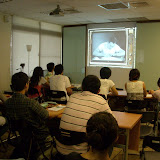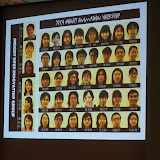Is the partnership between Paprikaas Interactive and Dreamworks a harbinger of things to come for the Indian animation industry?  PHOTO: Nickelodeon
PHOTO: Nickelodeon
BY Suhas Sreedhar // May 2009
Near the outskirts of Bangalore, India, sits the International Tech Park (ITPB), a shiny corporate metropolis that feels a world away from the bustling city center where pedestrians, cars, motorcycles, and cows routinely compete for space. The view inside the 18-hectare campus is a testament to outsourcing’s success. With glass and chrome buildings, dedicated power and water treatment plants, health clubs, malls, and a five-star hotel, the ITPB is home to automakers, electronics manufacturers, materials engineers, and several software companies. And it’s here that an animation house called Paprikaas Interactive Services is helping to shape the future of the global animation industry.
Paprikaas, which formed a partnership with Dreamworks Animation, of Glendale, Calif., last year, is in the animated services business, performing tasks like character modeling, set design, animation, and color correction on TV shows, video games, and movies for client studios worldwide. Founded in 2001, the company has done work for high-profile clients, including Nickelodeon, Sony Computer Entertainment, Microsoft, and Electronic Arts.
As I make my way to one of the conference rooms to meet Veerendra Patil, the company’s creative director, I see posters of classic Hollywood movies adorning the walls, including a large-scale replica of the original 1977 Star Wars one-sheet. When I meet Patil, an energetic man in his 40s, I learn that the upper management of Paprikaas is made up of a diverse group of people from varied backgrounds.
"Every top person in the company is not from the [animation] industry," he tells me. In fact, Nandish Domlur, the founder and CEO of the company, started his career as a heart surgeon in the United Kingdom, and Patil himself graduated with a degree in chemistry, though he states he was always interested in film and art, citing Star Wars as his inspiration.
The company’s workforce, on the other hand, is made up of mostly under-35 fine arts graduates from all over India, who learned advanced technical skills in things like texturing and object modeling in school but often lacked art lessons. To make up for it, new employees undergo six weeks of comprehensive company training and have weekly screenings of critically acclaimed movies to inspire creativity.
There are also those who come from the complete opposite background. Patil tells me about a Chennai artist with incredible talent named Ramani, who didn’t speak a single word of English but painted exquisite film posters. After being brought into Paprikaas, he was taught Adobe Photoshop, and within 2 hours he was making stunning digital art.
Learning and growth are recurring themes in my conversation with Patil. Working for high-profile clients allows the artists, supervisors, and executives to improve with the notes and feedback they receive.
"Our clients probably don’t want us to view it this way, but we basically see it as someone is paying us to learn," Patil remarks as he takes me around the studio.
There are long, darkened rows of cubicles, and other than the clicking of mice the place is pin-drop quiet. The area is loosely divided into units, so the animators sit near one another, as do the character modelers and texture artists. Each unit is further divided among sequence leads, who manage all the work done on a particular scene or segment of a project; group leads, who manage and coordinate the sequence leads; and finally a supervisor who oversees the entire unit.
The supervisors also deal directly with their counterparts in the client studios. So on a project like Nickelodeon’s ongoing TV show, ”Back at the Barnyard,” a lighting supervisor from Paprikaas discusses work with a lighting supervisor from Nickelodeon through a combination of videoconferencing, file sharing, and e-mail. The Nickelodeon supervisor then give notes to the supervisor, who relays the needed changes to members of his unit.
The formula of growing through feedback seems to be working: Over the last 18 months, the company has tripled in size to more than 600 employees and added R&D and visual effects teams, the latter of which will work on a number of Hollywood blockbusters coming out this year. Paprikaas also added a games division a couple of years ago, which has worked on big-time titles like God of War II and Gears of War , and recently formed a partnership with Electronic Arts to work on games like Warhammer Online and the FIFA Soccer and NBA titles.
Paprikaas’s emphasis on timeliness and quality attracted massive investment from Technicolor (a division of Thomson) a few years ago, setting the groundwork for the partnership with Dreamworks. The main purpose of the Dreamworks deal was to set up a dedicated studio and staff to work exclusively on Dreamworks projects. The group accounts for about 25 percent of all the work Paprikaas does, but it operates pretty autonomously from the rest of the company and has its own tightly controlled security. "We’re not even on the same network," Patil says. He didn’t even have the authority to grant me access to the floor the Dreamworks unit works on.
While Paprikaas has been expanding, the rest of the Indian animation industry has also flourished. According to the National Association of Software and Services Companies (NASSCOM), in New Delhi, the industry is expected to become a billion-dollar business within the next couple of years, nearly quadrupling its worth from five years ago.
Many big animation companies, now flush with cash, are looking to expand. Several see the domestic Indian market as a vast, untapped source of revenue and have begun to produce their own original content with the hopes of attracting Indian audiences. Others have tried to export their original, Indian-themed content to foreign markets. Both, as it turns out, are quite risky endeavors.
"Of course, the dream is always to make original content," Patil says, but then quickly cautions that ”it requires careful planning and consideration.”
Some recent, high-profile failures in original Indian animation seem to lend weight to his statement. But what impact will they have on the future of the animation industry?
About the Author
Suhas Sreedhar is a freelance journalist who has previously written for IEEE Spectrum about the future of music. He recently did some blogging and webcasting while working as the assistant director of the Center for Science Writings at the Stevens Institute of Technology.
 PHOTO: Nickelodeon
PHOTO: NickelodeonBY Suhas Sreedhar // May 2009
Near the outskirts of Bangalore, India, sits the International Tech Park (ITPB), a shiny corporate metropolis that feels a world away from the bustling city center where pedestrians, cars, motorcycles, and cows routinely compete for space. The view inside the 18-hectare campus is a testament to outsourcing’s success. With glass and chrome buildings, dedicated power and water treatment plants, health clubs, malls, and a five-star hotel, the ITPB is home to automakers, electronics manufacturers, materials engineers, and several software companies. And it’s here that an animation house called Paprikaas Interactive Services is helping to shape the future of the global animation industry.
Paprikaas, which formed a partnership with Dreamworks Animation, of Glendale, Calif., last year, is in the animated services business, performing tasks like character modeling, set design, animation, and color correction on TV shows, video games, and movies for client studios worldwide. Founded in 2001, the company has done work for high-profile clients, including Nickelodeon, Sony Computer Entertainment, Microsoft, and Electronic Arts.
As I make my way to one of the conference rooms to meet Veerendra Patil, the company’s creative director, I see posters of classic Hollywood movies adorning the walls, including a large-scale replica of the original 1977 Star Wars one-sheet. When I meet Patil, an energetic man in his 40s, I learn that the upper management of Paprikaas is made up of a diverse group of people from varied backgrounds.
"Every top person in the company is not from the [animation] industry," he tells me. In fact, Nandish Domlur, the founder and CEO of the company, started his career as a heart surgeon in the United Kingdom, and Patil himself graduated with a degree in chemistry, though he states he was always interested in film and art, citing Star Wars as his inspiration.
The company’s workforce, on the other hand, is made up of mostly under-35 fine arts graduates from all over India, who learned advanced technical skills in things like texturing and object modeling in school but often lacked art lessons. To make up for it, new employees undergo six weeks of comprehensive company training and have weekly screenings of critically acclaimed movies to inspire creativity.
There are also those who come from the complete opposite background. Patil tells me about a Chennai artist with incredible talent named Ramani, who didn’t speak a single word of English but painted exquisite film posters. After being brought into Paprikaas, he was taught Adobe Photoshop, and within 2 hours he was making stunning digital art.
Learning and growth are recurring themes in my conversation with Patil. Working for high-profile clients allows the artists, supervisors, and executives to improve with the notes and feedback they receive.
"Our clients probably don’t want us to view it this way, but we basically see it as someone is paying us to learn," Patil remarks as he takes me around the studio.
There are long, darkened rows of cubicles, and other than the clicking of mice the place is pin-drop quiet. The area is loosely divided into units, so the animators sit near one another, as do the character modelers and texture artists. Each unit is further divided among sequence leads, who manage all the work done on a particular scene or segment of a project; group leads, who manage and coordinate the sequence leads; and finally a supervisor who oversees the entire unit.
The supervisors also deal directly with their counterparts in the client studios. So on a project like Nickelodeon’s ongoing TV show, ”Back at the Barnyard,” a lighting supervisor from Paprikaas discusses work with a lighting supervisor from Nickelodeon through a combination of videoconferencing, file sharing, and e-mail. The Nickelodeon supervisor then give notes to the supervisor, who relays the needed changes to members of his unit.
The formula of growing through feedback seems to be working: Over the last 18 months, the company has tripled in size to more than 600 employees and added R&D and visual effects teams, the latter of which will work on a number of Hollywood blockbusters coming out this year. Paprikaas also added a games division a couple of years ago, which has worked on big-time titles like God of War II and Gears of War , and recently formed a partnership with Electronic Arts to work on games like Warhammer Online and the FIFA Soccer and NBA titles.
Paprikaas’s emphasis on timeliness and quality attracted massive investment from Technicolor (a division of Thomson) a few years ago, setting the groundwork for the partnership with Dreamworks. The main purpose of the Dreamworks deal was to set up a dedicated studio and staff to work exclusively on Dreamworks projects. The group accounts for about 25 percent of all the work Paprikaas does, but it operates pretty autonomously from the rest of the company and has its own tightly controlled security. "We’re not even on the same network," Patil says. He didn’t even have the authority to grant me access to the floor the Dreamworks unit works on.
While Paprikaas has been expanding, the rest of the Indian animation industry has also flourished. According to the National Association of Software and Services Companies (NASSCOM), in New Delhi, the industry is expected to become a billion-dollar business within the next couple of years, nearly quadrupling its worth from five years ago.
Many big animation companies, now flush with cash, are looking to expand. Several see the domestic Indian market as a vast, untapped source of revenue and have begun to produce their own original content with the hopes of attracting Indian audiences. Others have tried to export their original, Indian-themed content to foreign markets. Both, as it turns out, are quite risky endeavors.
"Of course, the dream is always to make original content," Patil says, but then quickly cautions that ”it requires careful planning and consideration.”
Some recent, high-profile failures in original Indian animation seem to lend weight to his statement. But what impact will they have on the future of the animation industry?
About the Author
Suhas Sreedhar is a freelance journalist who has previously written for IEEE Spectrum about the future of music. He recently did some blogging and webcasting while working as the assistant director of the Center for Science Writings at the Stevens Institute of Technology.

















沒有留言:
張貼留言